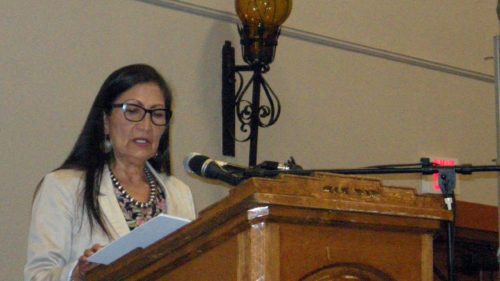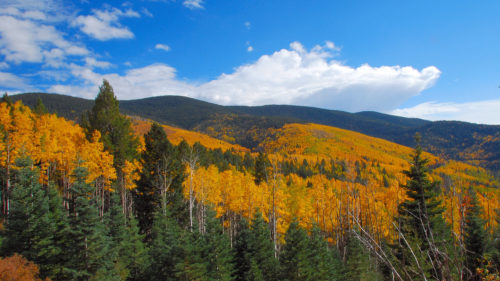By BEN NEARY
NMWF Conservation Director
ALBUQUERQUE — Knowing what it means when a bear huffs and stamps his front paws on the ground compared to when a bear makes eye contact and silently creeps toward you makes all the difference in how you should respond when you encounter one.
Daryl Ratajczak, a wildlife biologist with the U.S. Forest Service in New Mexico, has studied bear behavior extensively. At the New Mexico Wildlife Federation’s wildlife lecture on June 12 in Albuquerque, in a talk titled “The Language of Bears,” he gave tips on how to interpret how bears act. He spoke at Marble Brewery’s Northeast Heights location, 9904 Montgomery Blvd., NE.
“We all live in bear country here in New Mexico. So whenever you’re outside, you’re going to have an animal chattering at you. It could be a raven, could be a squirrel, or some other type of critter. It could be a coyote howling at you. Whenever that happens, we brush that off. We don’t care, it’s like we hear them chattering, we pay no attention to it,” Ratajczak said.
Then Ratajczak flashed a photo of a large bear on the screen. “But what happens when you have this guy suddenly trying to get your attention? Trying to tell you something?” he said. “It would probably be a smart thing to know what this guy’s trying to say if you encounter him.”
Ratajczak is former manager of the Appalachian Bear Center, located in Tennessee near Great Smoky Mountain National Park. He did black bear education and research at the center and rehabilitated orphaned cubs brought to him by the National Park Service and the Tennessee Wildlife Resources Agency, the state wildlife agency.
Ratajczak later worked for the Tennessee Wildlife Resources Agency as big game coordinator, overseeing state programs on bears and other wildlife. He then served as chief of wildlife for the Tennessee state agency. He joined the U.S. Forest Service a few years ago and came to New Mexico, where he said he appreciates the state’s plentiful wildlife.
When people and bears have an encounter, the bears are the most at risk, Ratajczak said. He said works to educate people about bear behavior mainly to help protect bears from the fallout of any misunderstandings.
New Mexico has only black bears, no grizzlies. Ratajczak said the black bears here generally only pose a minimal risk to people, but said his advice on how they act doesn’t apply to grizzlies or other bears elsewhere. Ratajczak also emphasized that people should never assume that a black bear’s behavior is completely predictable based on how it acts in response to human presence.
A black bear’s home range can be up to 150 square miles and they’ll wander farther in dry periods as they look for food. “They’re eating machines,” Ratajczak said. He said they mainly eat vegetable matter but said they will eat meat as well.
Bears typically come out of hibernation in the spring and need to feed heavily to make up for their loss of up to 30 percent of their body weight. “The springtime is really a time to be careful because they’re trying to restore all that weight they lost in their hibernation,” Ratajczak said.
Bears typically mate in June and July, Ratajczak said. He said people also should be particularly careful that time of year if they see two adult bears together in the woods. A mother bear with cubs, or any bear around a food source, also can pose problems.
Bears have eyesight that’s about as good as a human’s, Ratajczak said. He said their sense of hearing is much better but said that their sense of smell is astounding, perhaps 2,000 times better than a human’s — more acute than any other animal’s.
While bears are always alert for something to eat, Ratajczak said they typically don’t want anything to do with people.
Most of the time, when a person and bear encounter each other, Ratajczak said the bear will exhibit what he called defensive behaviors. Those include increasing the distance from the person while acting upset and nervous. He said the animals may snap their jaws closed, making a popping sound. He said they also may yawn and salivate.
In cases in which a bear wants a person to back away, Ratajczak said it may make a bluff charge or swat the ground with its front paws. Bears intend all those behaviors to indicate that they believe a person is too close and it’s making the animal nervous.
In the rare instances in which a bear is regarding a person as potential prey, Ratajczak said it will come in quietly and try to close the distance between itself and the person. He said the bear will typically keep its head low and may swing it from side to side.
A bear hunting a person will keep its eyes locked on the person and won’t let the person out of their sight, Ratajczak said.
Bear encounters don’t necessarily happen in the wild, Ratajczak said. He said it’s possible to encounter bears in towns and close to houses. “All of New Mexico is bear country,” he said. “You can be in your suburban home, come around that back deck and all of a sudden you have a close encounter with a bear. So it does not have to be way back in the wilderness.”
In dealing with a bear exhibiting defensive behavior, Ratajczak said it’s important for people to show the animal that they don’t pose a threat by retreating.
But when a bear’s approaching a person acting aggressively, Ratajczak said it’s important not to lie down and be a victim. If a bear comes at you, he said you must, “fight with all your might because your life depends on it.”
Ratajczak said he recommends people rely on bear spray over firearms for bear encounters. The spray, which uses special ground up peppers, is particularly effective on bears because of their sensitive sense of smell, he said. Firearms, meanwhile, can be difficult to use under stressful situations.



